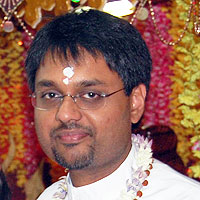From a satsang with SWAHA Pt. Dr. Umesh Persad
In the realm of spirituality, we understand the essence of Devi Maa as the embodiment of energy, a force both transcendent and undefinable within the vast cosmos. She permeates every facet of existence, from the ceaseless dance of the mind to the wonders of the natural world. In the sacred traditions of Sanaatan Dharma, this omnipresent energy takes myriad forms, manifesting abstract principles and subtle forces as divine beings. Thus, the pantheon of deities are a kaleidoscope of expressions, each mirroring the nuanced facets of a singular, subtle energy.
In ages long past, ancient rishis, through the art of meditation and profound spiritual experience, discerned the ultimate truth that unifies the entire universe: Oneness. These sages encoded their revelations within an assortment of elaborate stories or katha, imbuing them with deeper meanings that resonate through all of time.
In one such katha, during a primordial epoch, known as the time of pralay or dissolution, when the three realms of the universe were submerged in a vast ocean, Lord Vishnu reclined upon Ananta in a divine sleep. It is said that from the very wax of his ears, two formidable demons emerged, Madhu and Kaitabha. They thrived and grew amidst the infinite waters, realising that Devi was the primal cause of all existence. It was then that they heard, carried by the ethereal winds, the vaag bija, the seed mantra of speech. Devoting a millennium to rigorous penance, the demons eventually won the favour of the Divine Mother. Humbly, they petitioned, “Grant us the boon of invincibility, such that only we may determine our end.” With her benevolence, their plea was granted.
However, the demons soon unleashed a reign of terror, threatening the very fabric of existence. It was then that they encountered Lord Brahma, the progenitor of creation, seated upon a lotus springing from the navel of Lord Hari. They issued a defiant challenge, demanding that he either engage in battle or vacate his throne. In search of a solution, Brahmaji turned his focus to Lord Vishnu. Yet, Vishnu was said to be enshrouded in profound sleep, the Yoga Nidra of Mahaa Maayaa. Consequently, Brahmaji turned his gaze to Mahaa Shakti, beseeching her intervention. In response to his plea, the Divine Mother graced him with her presence and roused Lord Vishnu from his sleep. Awakened and reinvigorated, he courageously took up the mantle to confront the demons who had dared to challenge Brahmaji.
For five millennia, an epic battle raged on, with Lord Vishnu wielding his Sudarshan Chakra, symbolising the power of insight and clarity, and ultimately annihilating the demons. This profound narrative imparts a crucial lesson, one that underscores the significance of venerating Mahaa Maayaa, the Supreme Shakti, with unwavering devotion. She is the primordial cause, the divine orchestrator of all phenomena, the enduring refuge upon which we anchor our personal transformation.
In this allegorical tale, Lord Vishnu’s sleep under the sway of Yoga Nidra symbolises the individual mind ensnared by the ego, entangled within the web of its own thoughts. At its core lies the foundational notion of “I,” the sense of selfhood.
Within this spiritual landscape, Madhu and Kaitabha emerge from the earwax of Lord Vishnu, embodying the duality of pleasure and pain. These opposing forces, akin to the pendulum’s oscillation, constitute a wellspring of human suffering, nurturing the anxieties borne of desire and loss. The key lies in restraining the wandering mind, enabling the cultivation of inner peace.
Brahma, representing personal creativity, endeavours to rouse Vishnu to confront the demons. However, it becomes evident that Vishnu cannot vanquish them in isolation. He must turn to Mahaa Kaali, the embodiment of change and time, seeking her divine intervention.
Mahaa Kaali, the Supreme Spirit, the unifying force behind all creation, beckons us to recognize a reality larger than our limited selves. Each action, every emotional reaction, implores us to introspect deeply and discern the underlying motives. In doing so, we halt the capricious whims of our minds from overpowering us.
Bhagavan Vishnu’s eventual triumph over the demons, achieved through the Sudarshan Chakra, symbolising clear vision and insight, signifies the technique of witnessing, analysing and eliminating inner impurities. It serves as a transformative process to attain peace of mind.
This sacred narrative serves as a foundational cornerstone for all devotees. Madhu and Kaitabha, the embodiments of our inner turmoil, demand recognition. To confront them, we must first acknowledge the magnanimity of Mahaa Kaali’s presence, a force beyond ourselves. Subsequently, we embark on a path of spiritual evolution, choosing from the three spiritual methods of contemplation, prayer and meditation. This narrative embodies the contemplative method, urging us to reflect deeply on our thoughts and focus inwardly. By shifting our gaze from the external to the internal, we discern these two fears residing within us, allowing us to confront and ultimately dispel the forces of Madhu and Kaitabha that perpetually seek to assail our peace of mind.



